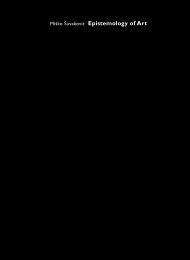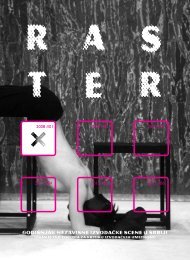Yearbook of the Independent Performing Arts Scene in Serbia - TkH
Yearbook of the Independent Performing Arts Scene in Serbia - TkH
Yearbook of the Independent Performing Arts Scene in Serbia - TkH
Create successful ePaper yourself
Turn your PDF publications into a flip-book with our unique Google optimized e-Paper software.
What was common to Yugoslav retro-avantgarde phenomena (and, consequently,to performance art-related ones), was <strong>the</strong>ir relation to ideology 3 .That relation was manifested <strong>in</strong> <strong>the</strong> work with ideological matrices <strong>of</strong> <strong>the</strong>local-specific socialist context. Such local avantgarde practices related topostmodernism <strong>in</strong> <strong>the</strong>ir use <strong>of</strong> retrograde tactics, <strong>in</strong> form <strong>of</strong>: appropriation,reference, repetition, and re-presentation or display, but also <strong>in</strong> <strong>the</strong>irengaged eclecticism. What <strong>the</strong>y were disclos<strong>in</strong>g were various totalitarianmodels and avantgarde utopian iconography rendered empty – devoid <strong>of</strong>mean<strong>in</strong>g.Art <strong>of</strong> <strong>the</strong> 90s emerged after <strong>the</strong> traumatic artistic pursuits <strong>of</strong> late socialism,as <strong>the</strong> art <strong>of</strong> <strong>the</strong> new global era. The 90s saw what used to be subversivestrategies <strong>of</strong> conceptual art (performance art <strong>in</strong>cluded) becom<strong>in</strong>gdom<strong>in</strong>ant ma<strong>in</strong>stream work<strong>in</strong>g practices.One <strong>of</strong> <strong>the</strong> characteristics <strong>of</strong> <strong>the</strong> N<strong>in</strong>eties is <strong>the</strong> redef<strong>in</strong>ition <strong>of</strong> <strong>the</strong> ontology<strong>of</strong> artwork accord<strong>in</strong>g to <strong>the</strong> idea <strong>of</strong> <strong>the</strong> work <strong>of</strong> art as critical <strong>in</strong>formation<strong>in</strong> <strong>the</strong> conceptual art <strong>of</strong> <strong>the</strong> Sixties and <strong>the</strong> Seventies. The difference isthat ‘<strong>the</strong> new work <strong>of</strong> <strong>the</strong> N<strong>in</strong>eties’ is be<strong>in</strong>g realized accord<strong>in</strong>g to <strong>the</strong> massivemedia <strong>in</strong>frastructure <strong>of</strong> late Postmodernism with <strong>the</strong> expectations <strong>of</strong><strong>the</strong> positive micro-social projection <strong>of</strong> political correctness (environment,local customs, <strong>the</strong> logic or repression <strong>of</strong> everyday life, <strong>the</strong> rights <strong>of</strong> <strong>the</strong>marg<strong>in</strong> <strong>in</strong> relation to <strong>the</strong> center, <strong>the</strong> gender issue, discursive formations <strong>of</strong>identity). This new art f<strong>in</strong>ds itself between <strong>the</strong> critique and <strong>the</strong> apology <strong>of</strong>social reality; <strong>in</strong> itself, it is an <strong>of</strong>fer to reality as an imag<strong>in</strong>ary and symbolicalrepresentation <strong>of</strong> possible ‘co-existence’ <strong>of</strong> identities and <strong>the</strong>ir differences 4 .Today, performance art represents a form <strong>of</strong> specific engagement and<strong>in</strong>tervention from <strong>the</strong> realm <strong>of</strong> art <strong>in</strong>to <strong>the</strong> culture and society – <strong>in</strong> <strong>the</strong> particularhistorical and social context. This practice plays with material effects<strong>of</strong> culture 5 which, <strong>in</strong> turn, represent different facets and manifestations <strong>of</strong>ideology. Performance art is, <strong>the</strong>refore, material production <strong>of</strong> potentialitiesrelat<strong>in</strong>g to <strong>the</strong> world which fosters its actuality 6 .3 Mar<strong>in</strong>a Grž<strong>in</strong>ić, Fiction Reconstructed. Eastern Europe, Post-Socialism & TheRetro-Avantgarde, Spr<strong>in</strong>ger<strong>in</strong> (Hg.), Vienna, 2000, p. 38.4 Miško Šuvaković, “Critical Phenomenology <strong>of</strong> Artwork: The Status, <strong>the</strong>Functions and <strong>the</strong> Effects <strong>of</strong> <strong>the</strong> Artwork at Manifesta 3”, available onl<strong>in</strong>e:http://www.ljudmila.org/scca/platforma2/suvakovicang.htm5 Culture understood as a system <strong>of</strong> signification which stands for every materialform <strong>of</strong> representation and its material effects. See: John Storey, CulturalTheory and Popular Culture: A Reader, Pearson Prentice Hall, 2006.6 Miško Šuvaković, “Koncepti i paradigme izvođenja u performans umetnosti”(Concepts and paradigms <strong>of</strong> performance <strong>in</strong> performance art), <strong>in</strong> MiškoŠuvaković, Konceptualna umetnost (Conceptual Art), Museum <strong>of</strong> ContemporaryArt Vojvod<strong>in</strong>a, Novi Sad, 2007, pp. 672-697.







